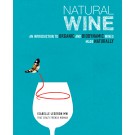Natural Wine
| Title of book: | Natural wine – an introduction to organic and biodynamic wines made naturally |
| Author: | Isabelle Legeron MW |
| Publisher: | Cico Books |
| Publication date: | 2014 |
| ISBN | 978 1 78249 100 2 |
| Pages: | 224 |
| Price: | £16.99 / US$24.95 |
 Disclaimer: I struggle with the whole “natural” wine description, mainly from a nomenclature angle. It implies other wines are not ‘natural’, which isn’t necessarily the case at all. To my mind these producers, or those advocating them, need to create a name that doesn’t, even inadvertently, besmirch their wine-producing colleagues.
Disclaimer: I struggle with the whole “natural” wine description, mainly from a nomenclature angle. It implies other wines are not ‘natural’, which isn’t necessarily the case at all. To my mind these producers, or those advocating them, need to create a name that doesn’t, even inadvertently, besmirch their wine-producing colleagues.
Such producers call their wines “natural” because, mostly, they don’t use additives or processing aids. But they can’t be called ‘no-additive’ wines because some/many(?) add sulphur dioxide prior to bottling, to prevent the wine becoming insanitary.
So this is a book on ‘largely no-additive wines’. ‘Pre-industrial’ perhaps. Neither really roll of the tongue so well. But both are arguably more accurate than ‘natural’. Added to which some of the folk who make these types of wines typically don’t want to be categorised. Yet here is a book attempting to do just that. It’s all quite contradictory, which is not to say that a book attempting to broaden the conversation is neither timely nor appropriate.
Nomenclature, and whether this misleads consumers, aside (absolutely not a criticism solely of this book), let’s review the book, as openly as I’m able. Indeed none of the above constitutes criticism of the book, except perhaps a missed opportunity by the author, who is a known champion of these minimum-additive styles of wines, to set the record straight and offer up an authentic category description. Legeron says such producers are organic or biodynamic as a minimum, but doesn’t confirm whether such status is certified, prior to adopting a “natural” moniker. Because of course both organic and biodynamic production can be certified and audited, unlike “natural”.
I completely agree with Legeron’s preamble about modern farming, the industrialisation and agro-chemicalisation of post second world war agriculture. She takes us through the principles of sound sustainable agriculture; principles that could (should?) apply to any agricultural production (though with implications for cropping levels and prices). Sprinkled throughout the book is lots of sensible, sustainable-to-a-greater-degree agricultural stuff, which isn’t solely the preserve of folk who like to use few or no processing aids and additives in their grape growing and winemaking. It’s just about looking after the environment in a sustainable way, thinking about living things and how they interact. Stuff that could easily be found in a tome on sustainable thinking in farming.
I like the short chapters which introduce various topics. It keeps the information bite-sized. Interspersed in these chapters, is a rich patina of double-page-spread stories from growers. These add texture and dimension to the nittier-grittier stuff that Legeron outlines.
She sums up the unpredictability of the wines of this ‘movement’: “if you pick grapes and squash them in a bucket, you will, with a little luck, end up with wine.” Luck is an issue – you can equally end up with undrinkable, faulty rubbish.
Nonetheless, I’m delighted to read there are moves to define and categorise this group of wine. A number of associations exist, each of which have their own charter. I’m not sure how it would help with an umbrella charter, something that could be audited, but I like Legeron’s subtraction idea (95): step one: remove all non-organic vineyards from the equation. From the remaining pool remove anyone using cultured yeasts … then enzymes … then sterile filtration … etc. You will arrive at an ever decreasing group of increasingly non-manipulative producers. Of course this equation doesn’t deal at all with the quality of wine produced, it just arrives at a (small) quantity of folk using less and less manipulation.
The book perhaps starts off a little evangelical, and mellows with progression from something of a conversion manual into something more objective. But it still ends up a useful read, especially, arguably, for one struggling with the slippery nature of nomenclature, and sometimes, substance.
About 40% of the book introduces wines the author recommends, a ‘starter for ten’ on “natural” wines; an introduction to befriending minimally-manipulated wines – “the best way to enjoy natural wines is to try to forget everything you think you know about wine, and start afresh”. Not necessarily an easy ask.



